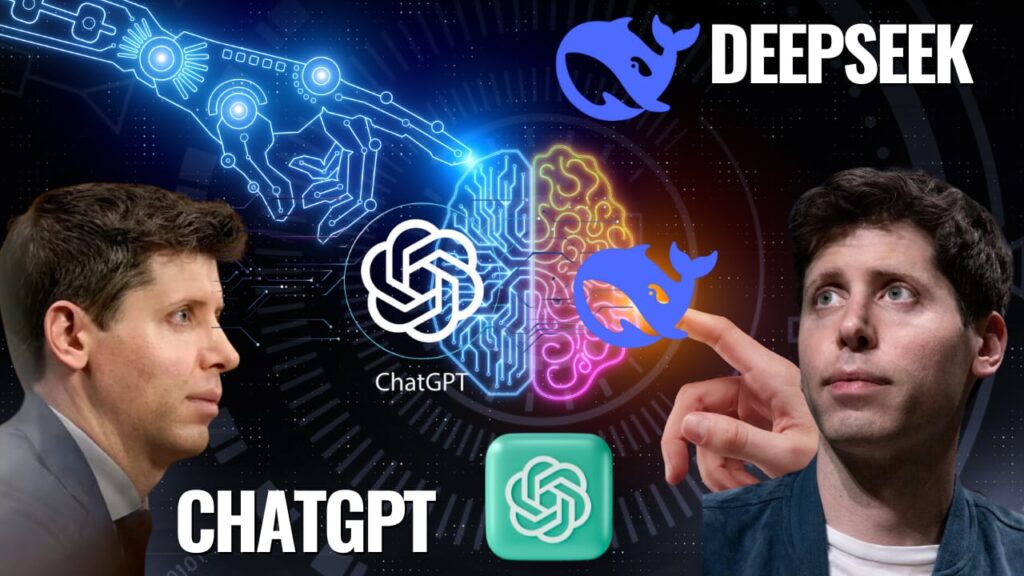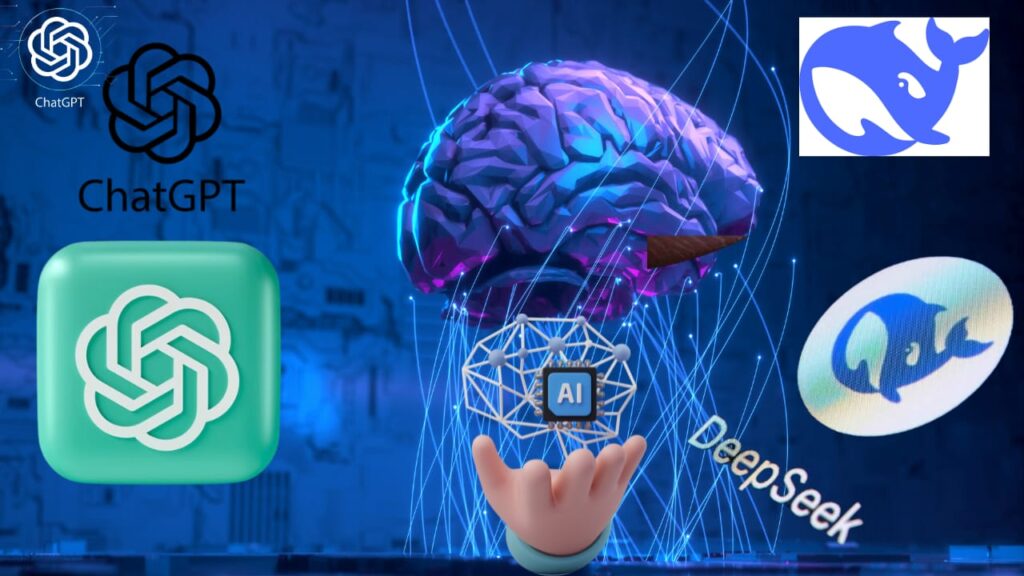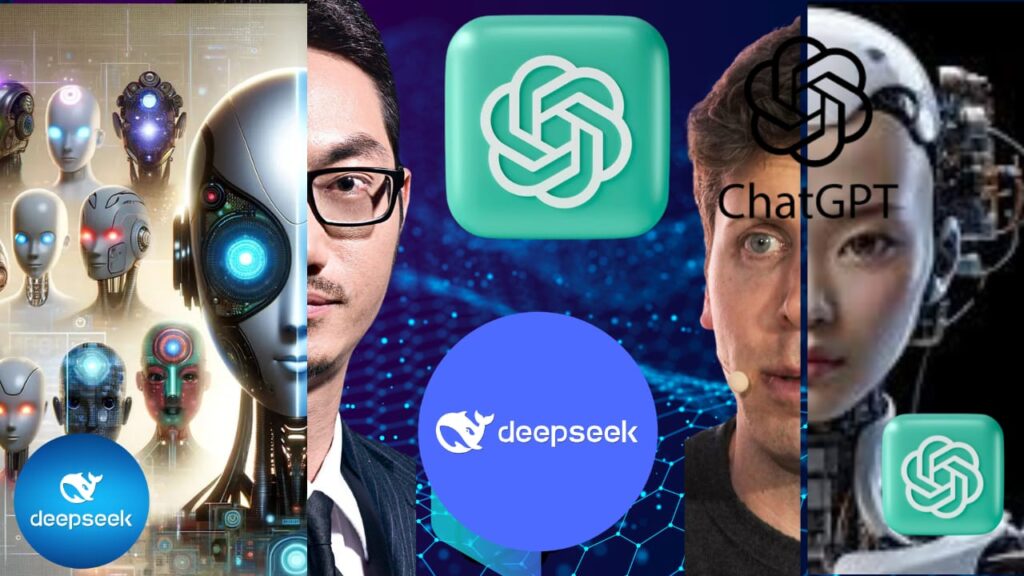Compare Chat GPT vs DeepSeek AI in 2025: features, costs, and performance unveiled
Introduction to Chat GPT vs DeepSeek AI
In February 2025, the AI landscape is buzzing with competition between Chat GPT, particularly its latest version GPT-4o from OpenAI, and DeepSeek AI, with its notable model DeepSeek-R1. Both are at the forefront of artificial intelligence, offering unique capabilities that cater to different needs. This article explores their architectures, performances, training methodologies, costs, accessibility, and real-world applications, providing a comprehensive comparison for users and developers.

Model Overview
Chat GPT (GPT-4o) is a multimodal large language model (LLM) developed by OpenAI, capable of processing and generating text, audio, and images in real time. It’s designed for versatile applications, from conversational AI to complex problem-solving, with rapid response times and enhanced multilingual capabilities.
DeepSeek AI (DeepSeek-R1), on the other hand, is a Chinese AI company’s model focused on text-based reasoning. Released in January 2025, DeepSeek-R1 is open-source, trained via large-scale reinforcement learning, and aims to rival top models like OpenAI’s o1 in math, code, and reasoning tasks.
Comparative Analysis
Architecture and Size
- GPT-4o: Its architecture is not fully disclosed, but it’s a transformer-based model handling multiple modalities through a unified framework, making it versatile for diverse inputs.
- DeepSeek-R1: Based on a Mixture-of-Experts (MoE) architecture, it has 671 billion total parameters, with only 37 billion activated per token, enhancing computational efficiency.
Performance and Capabilities
Both models are competitive in reasoning and problem-solving, but their strengths differ:
- GPT-4o excels in handling text, audio, and images, setting benchmarks in multilingual and vision tasks, with rapid response times comparable to human interactions.
- DeepSeek-R1 is primarily text-based, achieving performance comparable to OpenAI’s o1 in math, code, and reasoning, making it ideal for technical and scientific applications.
Training Data and Methodology
- GPT-4o was trained on a vast corpus including text, images, and audio, likely using supervised and reinforcement learning, though exact details are not public.
- DeepSeek-R1 used large-scale reinforcement learning with some supervised fine-tuning (SFT) on cold-start data, focusing on reasoning capabilities, with a diverse and high-quality dataset.

Cost and Efficiency
- GPT-4o: Estimated training costs are high, likely in the tens of millions, similar to previous models like GPT-4, which cost around $100 million, due to its advanced multimodal capabilities.
- DeepSeek-R1: Claimed training cost is approximately $6 million, significantly lower, attributed to optimized techniques and possibly lower-cost computational resources, using 2.788 million H800 GPU hours at an estimated $2.15 per GPU hour.
Openness and Accessibility
- GPT-4o: Closed-source, accessible via OpenAI’s API, limiting direct access to its architecture and weights, which may restrict customization.
- DeepSeek-R1: Open-source, with code and weights publicly available, fostering collaboration and innovation within the AI community, enhancing accessibility for researchers and developers.
Real-world Applications
- GPT-4o: Its multimodal nature suits applications like customer service, content creation, and data analysis, where handling audio and images is crucial, expanding its utility.
- DeepSeek-R1: Focused on text-based tasks, it’s well-suited for scientific research, programming assistance, and complex data interpretation, leveraging its reasoning strengths.
Future Prospects
Both companies are expected to continue advancing their models, with OpenAI likely releasing successive versions and DeepSeek AI expanding its open-source offerings. This competition is poised to drive innovation, benefiting the broader AI community through enhanced tools and technologies.
Conclusion
In summary, while GPT-4o offers versatility through its multimodal capabilities, DeepSeek-R1 stands out for its cost efficiency and open-source accessibility, particularly for text-based reasoning tasks. Choosing between them depends on specific needs, with GPT-4o ideal for diverse applications and DeepSeek-R1 appealing for technical, community-driven projects.
Detailed Survey Note: Comprehensive Comparison of Chat GPT and DeepSeek AI
This survey note provides an in-depth analysis of Chat GPT (GPT-4o) and DeepSeek AI (DeepSeek-R1), based on recent data as of February 2025, aiming to offer a thorough understanding for users and developers. The comparison covers architecture, performance, training, cost, accessibility, and applications, ensuring a strict superset of the information in the introduction.
Background and Context
The AI field has seen rapid advancements, with Chat GPT, developed by OpenAI, and DeepSeek AI, a Chinese company, emerging as key players. Chat GPT’s latest, GPT-4o, introduced in May 2024, is a multimodal model, while DeepSeek AI released DeepSeek-R1 in January 2025, focusing on reasoning with an open-source approach. This comparison is timely, given their recent developments and the ongoing debate about cost, accessibility, and performance.
Model Architecture and Size
- GPT-4o: The architecture is a transformer-based model, not fully disclosed by OpenAI, but known for integrating text, audio, and images in a single neural network. This multimodal approach enhances its versatility, with rapid response times noted at 320 milliseconds for audio inputs (Wikipedia: GPT-4). The parameter count is not publicly revealed, but it’s designed for efficiency and cost-effectiveness compared to predecessors.
- DeepSeek-R1: Built on a Mixture-of-Experts (MoE) architecture, DeepSeek-R1 has 671 billion total parameters, with 37 billion activated per token, as detailed in its GitHub repository (DeepSeek GitHub: DeepSeek-R1). This design, validated in DeepSeek-V3, uses Multi-head Latent Attention (MLA) and DeepSeekMoE, optimizing inference speed and training cost.
Performance and Capabilities
Performance comparisons reveal distinct strengths:
- GPT-4o: Excels in multilingual tasks, vision, and audio, with state-of-the-art results in benchmarks like MMLU (82% in 5-shot scenarios for its mini version) (TechTarget: GPT-4o explained). It matches GPT-4 Turbo in English text and coding, with enhanced non-English language support, making it versatile for global applications.
- DeepSeek-R1: Focused on text-based reasoning, it achieves performance comparable to OpenAI’s o1 in math, code, and reasoning tasks, as noted in its technical report (DeepSeek API Docs). It outperforms on benchmarks like AIME 2024 (71.0% pass@1), demonstrating strong reasoning capabilities, ideal for technical and scientific tasks.

Training Data and Methodology
- GPT-4o: Trained on a large corpus including text, images, and audio, with details scant but known to include publicly available data and third-party licensed data (DataCamp: What is GPT-4o). The training involved a single neural network for end-to-end processing, enhancing its multimodal capabilities, though specifics on data volume (e.g., 45TB for GPT-3) are not updated for GPT-4o.
- DeepSeek-R1: Utilizes a multi-stage training process, starting with reinforcement learning (RL) to create DeepSeek-R1-Zero, then incorporating cold-start data for supervised fine-tuning (SFT) before further RL, as outlined in its GitHub documentation (DeepSeek GitHub: DeepSeek-R1). This approach, using group relative policy optimization (GRPO), focuses on accuracy and format rewards, with training on diverse, high-quality tokens, though exact data sources are not detailed.
Cost and Efficiency
Cost is a significant differentiator:
- GPT-4o: Estimated training costs are high, with previous models like GPT-4 costing around $100 million, as reported by industry estimates (Team-GPT: How Much Did It Cost to Train GPT-4?). GPT-4o’s advanced capabilities likely maintain similar or higher costs, reflecting the computational intensity of multimodal training.
- DeepSeek-R1: Claimed training cost is approximately $6 million, based on 2.788 million H800 GPU hours, with an estimated cost per GPU hour of $2.15, derived from cloud rental prices (Tom’s Hardware: Nvidia’s AI GPUs are cheaper to rent in China). This efficiency is attributed to optimized techniques and possibly lower-cost resources in China, making it a cost-effective option.
Openness and Accessibility
- GPT-4o: Closed-source, accessible via OpenAI’s API, limiting direct access to its architecture and weights. This restricts customization but ensures controlled deployment, suitable for commercial applications (OpenAI).
- DeepSeek-R1: Open-source, with code and weights available on GitHub, fostering community collaboration and innovation (DeepSeek GitHub: DeepSeek-R1). This accessibility is a significant advantage for researchers, allowing fine-tuning and local deployment, though it may require high-performance hardware for larger models.
Real-world Applications
- GPT-4o: Its multimodal capabilities enable applications in customer service, content creation, and data analysis, where handling audio and images is crucial. For instance, it’s used for real-time translation and creative content generation, enhancing user experience (DataCamp: GPT-4o Guide).
- DeepSeek-R1: Focused on text-based tasks, it’s ideal for scientific research, programming assistance, and complex data interpretation. Its reasoning strengths suit applications like legal document analysis and financial forecasting, with community-driven use cases expanding its utility (DeepSeek Website).
Future Prospects and Industry Impact
Both companies are poised for growth, with OpenAI likely to release successive versions, building on GPT-4o’s success, and DeepSeek AI expanding its open-source offerings, potentially challenging Western dominance in AI. The competition is expected to drive innovation, with DeepSeek-R1’s low cost and openness possibly democratizing AI development, while GPT-4o’s multimodal capabilities may lead in diverse, commercial applications.
Conclusion
This survey note highlights that while GPT-4o offers versatility through multimodality, DeepSeek-R1’s cost efficiency and open-source nature make it a compelling choice for text-based reasoning tasks. The choice depends on specific needs, with GPT-4o suited for broad, multimodal applications and DeepSeek-R1 appealing for technical, community-driven projects, reflecting the dynamic AI landscape in February 2025.

FAQs for Chat GPT vs DeepSeek AI
1. What is the main difference between Chat GPT and DeepSeek AI in 2025?
Chat GPT (GPT-4o) by OpenAI is a multimodal AI excelling in text, audio, and image tasks, while DeepSeek AI (DeepSeek-R1) focuses on text-based reasoning, offering cost-efficiency and open-source access as of February 2025.
2. Which AI is better for coding: Chat GPT or DeepSeek AI?
DeepSeek AI, particularly DeepSeek-R1, outperforms Chat GPT in technical tasks like coding and math reasoning, matching OpenAI’s o1 model, making it a top choice for developers in 2025.
3. Is DeepSeek AI free to use compared to Chat GPT?
Yes, DeepSeek AI is fully free and open-source, unlike Chat GPT, which offers a free tier but charges $20/month for advanced features like GPT-4o, as of February 2025.
4. How do Chat GPT and DeepSeek AI compare in cost efficiency?
DeepSeek AI was trained for about $6 million, significantly less than Chat GPT’s estimated tens of millions, making it a budget-friendly option for AI users in 2025.
5. Can Chat GPT handle images and audio better than DeepSeek AI?
Yes, Chat GPT’s GPT-4o excels in multimodal tasks (text, images, audio), while DeepSeek AI focuses solely on text-based performance, as noted in February 2025 comparisons.
6. Why is DeepSeek AI considered a Chat GPT rival in 2025?
DeepSeek AI’s open-source model, low-cost training, and strong reasoning skills challenge Chat GPT’s dominance, especially after topping app charts in January 2025.
7. Which AI is more accessible for researchers in 2025?
DeepSeek AI’s open-source nature makes it more accessible for researchers to customize, unlike Chat GPT’s closed-source API model, as of February 2025.
Key Citations
- Wikipedia: DeepSeek, comprehensive overview of DeepSeek AI company
- DeepSeek GitHub: DeepSeek-R1, technical details and open-source access
- OpenAI, official website with GPT-4o information
- DeepSeek Website, platform for interacting with DeepSeek AI models
- Wikipedia: GPT-4, detailed information on GPT-4 and related models
- TechTarget: GPT-4o explained, everything you need to know about GPT-4o
- DeepSeek API Docs, news on DeepSeek-R1 release and performance
- DataCamp: What is GPT-4o, guide to GPT-4o functionalities
- Team-GPT: How Much Did It Cost to Train GPT-4?, cost analysis of AI training
- Tom’s Hardware: Nvidia’s AI GPUs are cheaper to rent in China, pricing insights
- DataCamp: GPT-4o Guide, comprehensive guide on GPT-4o applications
#ChatGPTvsDeepSeekAI, #AIComparison2025, #DeepSeekR1, #ChatGPT4o, #BestAI2025, #AICodingTools, #OpenSourceAI, #AIReasoning, #TechTrends2025, #CostEfficientAI,
